Guide to Customer Retention: How To Drive Loyalty and Repeat Purchases on Shopify
Customer retention is the holy grail of retail. Not only are they easier to sell to, but repeat shoppers also tend to contribute more to your bottom line. Research has shown that it’s 5 to 10 times more expensive to acquire new customers and that on average, existing patrons spend 67% more than first-time buyers.
With numbers like that, it’s easy to see why businesses that focus on customer retention do well. In fact, a study by SumAll found that companies with a higher rate of repeat customers generate 47% more revenue.
Here’s the good news: there are several ways to increase repeat spending in your ecommerce store. Have a look at the marketing workflows below and start implementing them in your business.
Get MESA free for 7-days and enjoy support from automation experts!
Topics:
Establish a strong emotional connection with your customers
Loyalty tools and tactics can do wonders for customer retention (and we’ll get to them in a bit), but ultimately, people will choose to buy from your repeatedly if they have a genuine connection with your brand.
So, strive to forge strong relationships with your target audience. Do what you can to get them to know, like, and trust you. Here are a couple of suggestions:
Tell stories
The line “stories sell,” gets repeated a lot, but that because it’s true. Scientific studies have shown that human brains are more active and receptive when narratives are involved. Stories not only activate the language processing parts of the brain, they also light up the sensory cortex, which is responsible for the sense of sight, sound, touch, taste, and smell.
With all that being said, if you’re not incorporating stories in your marketing, you’re missing out on engagement opportunities.
So, start telling more stories. Share the tale of how you started your business. Shed light on the stories behind your products. Talk about the lessons you’ve learned on your journey. Your storytelling opportunities are endless.
Hiut Denim, a jean manufacturer and retailer, is one example of a business that knows how to tell a good tale.
Check out the documentary below, which they co-produced with Shopify.
In addition to detailing how Hiut Denim is bringing jean manufacturing (and jobs) back to Cardigan, the film tells the stories of individual factory workers, making the documentary all the more poignant and memorable. (And the part of the story involving Kensington Palace and Meghan Markle definitely didn’t hurt.)
Be authentic
Brand authenticity starts with identifying your businesses’ values and conveying them through your words and actions. For example, if you started your business because you want to help the environment, then everything that you say and do should reflect that.
A great example of this in action comes from jewelry retailer Francesca, which was founded on the belief that “success means nothing unless you’re giving back.”
Hannah & Rachel Vasicek, the founders of the company, have demonstrated their commitment to their values time and time again. They routinely donate their earnings to numerous organizations — including Make-a-Wish, Heart Foundation, Dementia Australia — and in many cases, they even design collections with specific causes in mind.
So far, Francesca has raised $200,000 and it continues to actively find ways to give back.
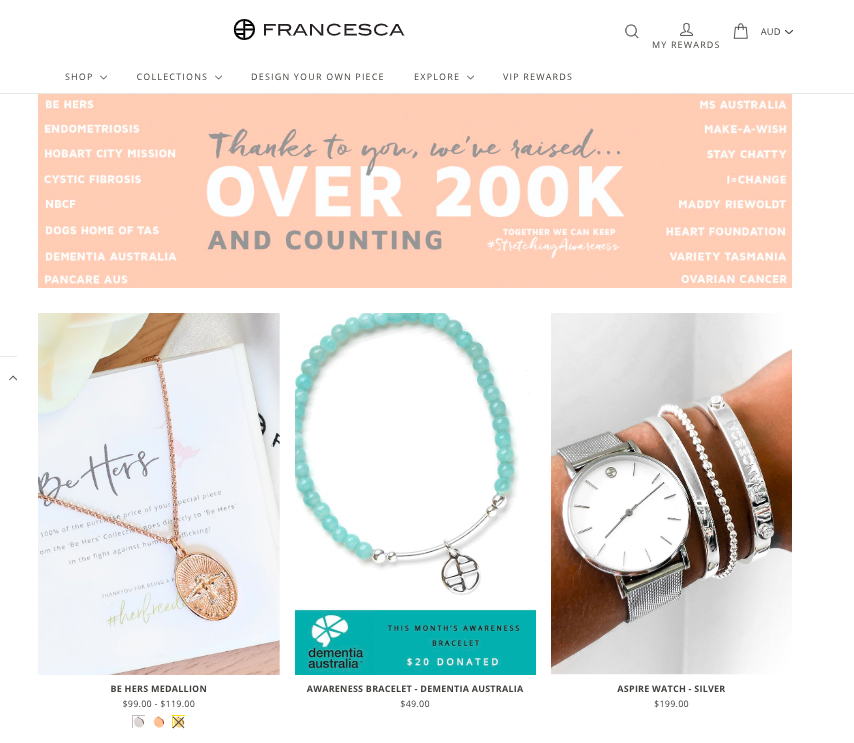
Another way to convey authenticity? Be real about your entrepreneurship struggles. This doesn’t mean you should start oversharing or complaining about the issues in your company. But occasionally talking about the ups and downs in your business makes you more relatable. This, in turn, strengthens the connection customers have with your brand.
Monica Escobar Allen, the founder of kids shop The MoMeMans, does this really well. Monica is open about her challenges as an entrepreneur and the lessons that she’s learned.
Establish an enticing loyalty program
We can’t talk about customer retention without bringing up rewards programs — these initiatives are the backbone of your loyalty strategy.
Loyalty initiatives come in all shapes and sizes, but the most successful ones all have something in common. Shopify cites that the top 3 reasons loyalty programs succeed are:
- Easy to use: 53%
- Gives me great discounts: 39%
- Easy to understand: 37%
Keep those three factors top of mind when you’re establishing and running your loyalty efforts. One example of a great program comes from the beauty and cosmetics retailer Stage & Screen FX.
The structure of their Spotlight Rewards program is simple: $1 is equivalent to one rewards point. Stage & Screen FX makes it easy to earn points and gives people plenty of options to rack up more rewards.
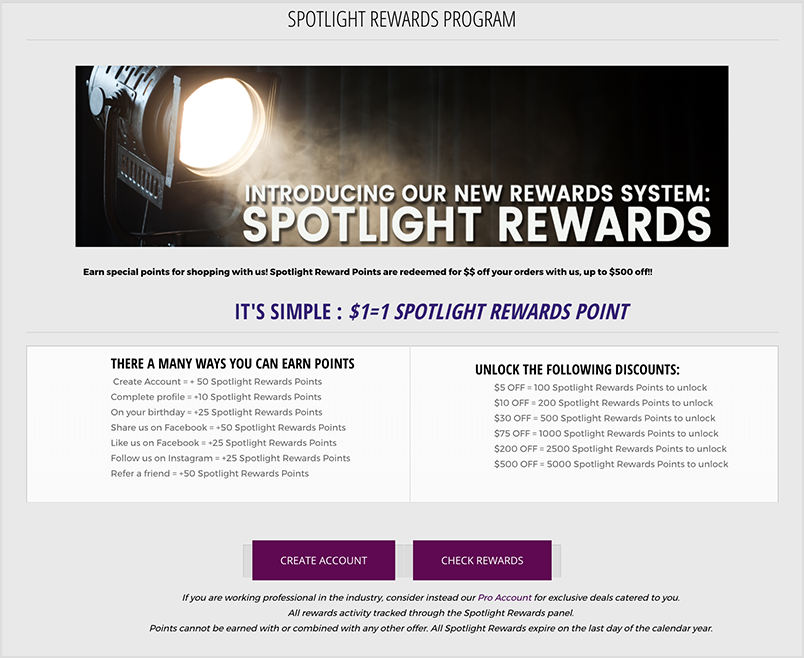
In addition to completing purchases, members can earn extra points when they:
- Complete their profile
- Like Stage & Screen FX on Facebook
- Follow the business on Instagram
- Refer a friend
- Celebrate their birthday
- and more
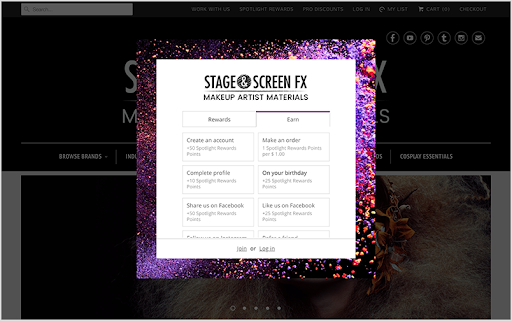
Stage & Screen FX are also quite generous with their rewards, and customers can redeem rewards of up to $500 off.
Stay top of mind with regular contact
Consistent contact with shoppers is critical when you’re looking to drive repeat purchases. After all, people won’t buy from you if they forget you exist.
It’s important to maintain regular communication with your customers. Keep them updated with company news and get in touch whenever you’re running a promotion.
Another excellent technique is to segment customers based on their last visit or purchase, and then reach out to those who haven’t bought anything in a while. RK Collections, an e-tailer that sells appare and accessories, does just that.
RK Collections runs “win-back” campaigns using , in which they send a special coupon — along with relevant product recommendations — to customers who haven’t bought anything within the last 30 days.
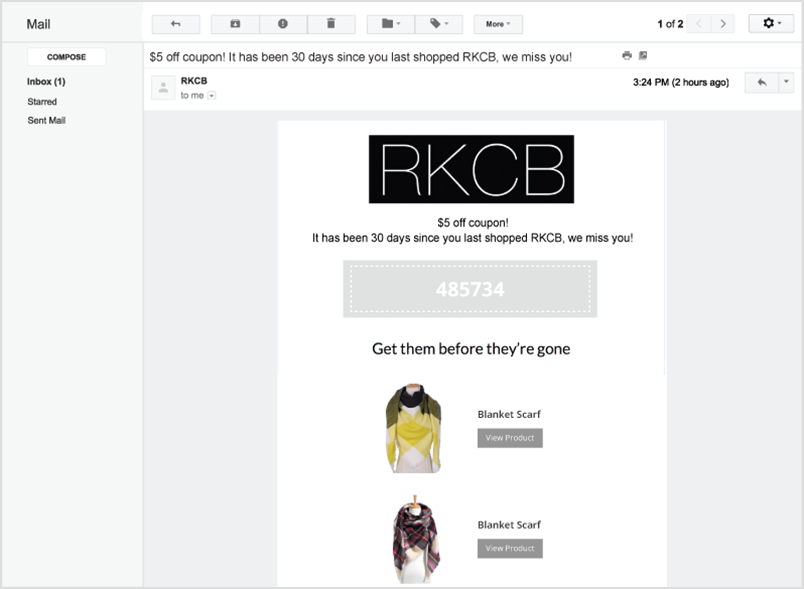
By the way, remember that customer outreach doesn’t have to be limited to email. If some of your shoppers are open to receiving your messages via text or instant messaging, then it might be a good idea to add them to your communications mix.
Nine West, for example, sends marketing messages via text and encourages web visitors to sign up by offering a 15% discount.
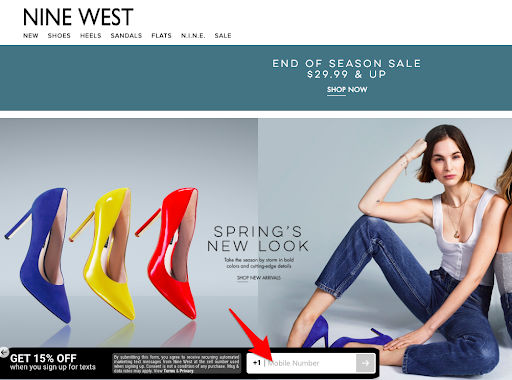
Keep thinking about the *next* purchase
Did you know that 68% of customers will never purchase a second time? It’s not a very uplifting stat, but here’s some good news: once you’ve gotten someone to purchase for a second time, it’s much easier to get them to purchase again.
According to The Data Point:
While only 32% of first purchases will make a second purchase, 53% of customers that make a second purchase will make a third. And with each successive purchase, the likelihood of them coming back increases.
The key takeaway here is to be very strategic with how you market to new customers. If you want to turn first-time shoppers into repeat buyers, your messages or offers should be on-point and compelling.
How do you do that?
Start by looking at your data. Study your customer journeys and find trends that you can use in marketing. For instance, if a shopper buys product A, what would they typically buy next? You can use the answer that question to make relevant product suggestions and offers.
Another tip is to incorporate timing with your marketing messages. Let’s say you’re selling maternity clothes. If a woman buys from you from when she’s 3 months pregnant, chances are she’ll need 6-month maternity in three months time. With that in mind, you can get in touch with her in 2 months or so with the right product suggestions.
These are just a few examples of how you can leverage in your business. Look into the information you have about your customers and see how you can use those insights in your marketing.
Bottom line
How can you drive more repeat purchases? Start by forging strong connections with your customers, and then drive loyalty and sales through regular communications. Finally, make it a point to collect the data you need to drive the “next” purchase of your customers.
Remember, successfully converting a new shopper is one thing, but getting them to purchase from you again and again, is a whole other ballgame. But don’t worry — by following the tips above, beefing up your customer retention strategy is completely doable.


